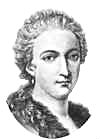
Maria Gaetana Agnesi (1718-1799)
Even though Maria Gaetana Agnesi is remembered for her contribution to mathematics, we should also remember her for her acts of piety and charity. Though growing up in a wealthy home, she herself lived simply. As soon as she had the opportunity to pursue her dream of working with the poor, she gave up mathematics and all of the notoriety that went with it. We can admire her for her humility and courage as well as her amazing intellect. She gave all for God’s glory.
Maria Gaetana Agnesi was born in Milan on May 16, 1718 to wealthy parents. She was the oldest of the 21 children that her father had by three wives. Her father, Pietro Agnesi, recognized that his daughter was a child prodigy and engaged the best tutors available for her. By the age of five Maria mastered French and by the age of nine she had mastered Latin, Greek, and Hebrew. During her teens she mastered Mathematics.
By the time she was nineteen, Maria could carry on conversations with renowned philosophers, mathematicians, and theologians. Her father enjoyed showing her off and invited Count Carlo Belloni, a famous philosopher, to host conversazionesat the Palazzo Agnesi where renowned intellectuals would gather to impress each other with their wit and wisdom.
It was fashionable for the wealthy in Europe to host gatherings in their salonsin the 18th century. Pietro Agnesi began inviting people to his salons when Maria Gaetana was only five years old. She entertained her father’s guests by speaking in fluent French and responding to their questions with a quick wit that amazed them all.
Maria’s reputation for her genius had spread and people came to see and hear her for themselves. For the next fifteen years people came to appreciate the wit and wisdom of this remarkable young woman during the conversations. In 1738 Maria published a set of complex essays on natural science and philosophy called Propositiones Philosophicae, that summarized some of the intellectual discussions that were held in the salons. In these essays she made sure to express her opinion that women should be educated.
By the time Maria Gaetana was twenty she had begun the work for which she was the most famous, Analytical Institutions, which dealt with differential and integral calculus. Calculus was being discussed by high level mathematical thinkers and was difficult for the average student to understand. It was no problem for Maria. She loved mathematics very much and wanted to make it accessible for the beginning student, so she wrote her own textbook. The two volume work was finished around 1748 or 1749.
In her textbooks Maria Gaetana used language and illustrations that would enable her to make calculus understandable in a clear and concise way. Her books were so successful that she was elected to the Bologna Academy of Sciences. In the first place, Maria departed from other authors by writing her books in the vernacular. The secretary of the Academy of Sciences of Bologna exclaimed, “What neatness! What concision! What order ! What clarity!”[1]High praise indeed! Her two volume work was used as the standard text in mathematics for students for many decades.
A very deep and personal reason that Maria Gaetana wanted to make mathematics more accessible for all students, including females, was that she believed that science is a divine gift from God that should be nurtured, and all people should praise Him for this gift. Mathematics as a philosophy and science lends itself to studying about the universe which God created. She taught that women as children of God had as much capacity as men for the sciences and should be able to realize the joy of understanding God’s creation better through mathematics.
Maria’s deep faith in God and love for the poor and destitute led her to lay aside her mathematics in her later years. After her father died, Maria signed off on the property she would have inherited giving it to her older brothers in exchange for a monthly stipend. She then was free to fulfill her longing to work among the poor.
For the rest of her life, about 47 years, Maria Gaetana used her wealth to work among the disadvantaged. She established homes for the poor. She lived among the destitute elderly in a home that she founded. By the time she died in 1799 at age eighty-one, she had given away everything she had ever owned. She was buried in a pauper’s grave in a cemetery outside the city walls of Milan. There is no physical monument at the gravesite, but praise God her writings and her work among the poor will ever be remembered.
Maria Gaetana was recognized as a champion for women. She held firmly to the belief that there were no significant cognitive barriers preventing women from performing similarly to men in intellectual activities. She opposed three main kinds of objections to educating women – tradition, the alleged inability of the female mind, and the social disruption that would supposedly follow from allowing women to be educated.
Maria proved all of these arguments false with her own life. She was intellectually gifted above most of the men in her day. Far from social disruption, Maria brought social justice to many. She used her tremendous ability for organization to aid the poor even though it cost her everything.
Now, over 200 years later, we can point to Maria Gaetana herself along with scores of other brilliant women who put a lie to the view that women are not as capable as men. I can’t wait to have conversaziones with Maria Gaetana in Heaven!
[1]Massimo Mazzotti. The World of Maria Gaetana Agnesi, Mathematician of God(Baltimore, MD: John Hopkins University Press, 2007) p 120.

